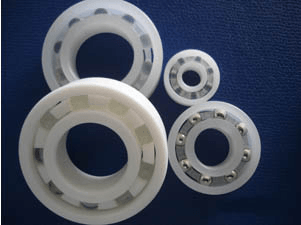Plastic Bearings Information
Plastic bearings are used in wet and corrosive environments, clean environments, areas that are difficult to lubricate, and applications that require non-magnetic bearings.
Video credit: igus® inc. / CC BY-SA 4.0
Materials
They are made from a variety of plastic materials and are often self-lubricating to provide smooth operation and greater durability.
Polytetrafluorethylene (PTFE), a heat-tolerant polymer, is a fluorinated thermoplastic with outstanding chemical resistance, low leachability, and excellent lubricity.
Teflon® , a registered trademark of DuPont Dow Elastomers, is a proprietary form of PTFE used with many plastic bearings.
Nylon, a category that comprises several grades of polyamides, is commonly used as a bearing surface material because of its toughness, resistance, and pressure ratings.
Semi-crystalline acetal polymers offer excellent lubricity, fatigue resistance, and chemical resistance; however, they suffer from outgassing problems at elevated temperatures and become brittle at low temperatures.
Types
- Angular contact bearings have one or two rows of balls that form a contact angle between the races and balls.
- Radial ball bearings have one or two rows of balls that rotate in a deep, machined groove.
- Flange-mounted bearings are used when the shaft axis is perpendicular to the mounting surface.\
- Hanger bearings are rotational and often used with drive and screw conveyor shafts.
- Linear bearings are designed for components that need to be moved along a straight line with a high degree of accuracy.
- Pillow block bearings provide strong load support for rotating shafts.
- Plain bearings and sleeve bearings are used to constrain, guide, or reduce friction.
- Cylindrical roller bearings have high radial load capacity and support moderate thrust loads.
- Spherical roller bearings are self-aligning devices that are suitable for high-capacity loads.
- Tapered roller bearings consist of an inner ring (cone), an outer ring (cup), a cage and rollers that are profiled to distribute the load evenly.
- Takeup bearings are used primarily to correctly tension conveyor belts and systems, or to align tracks. They are available in three component types: bearing, frame, and take-up assembly (frame with bearing).
- Thin-section plastic bearings have small cross-sections with respect to their diameter.
Specifications
Specifications for plastic bearings include bore size, outside diameter or length, and overall width or height.
 The bearing industry uses a standard, numbered system to identify plastic bearings with metric diameter bores. Bore sizes 00 (10 mm), 01 (12 mm), 02 (15 mm), and 03 (17 mm) have the smallest diameter bores. For bore sizes 04 (20 mm) and up, multiplying the bore size by five yields the bore diameter in millimeters.
The bearing industry uses a standard, numbered system to identify plastic bearings with metric diameter bores. Bore sizes 00 (10 mm), 01 (12 mm), 02 (15 mm), and 03 (17 mm) have the smallest diameter bores. For bore sizes 04 (20 mm) and up, multiplying the bore size by five yields the bore diameter in millimeters.
Hexagonal bores are measured across the flats. Tapered bores are measured by the smaller diameter. For housed bearings, the outside diameter includes the housing. For flanged devices, the outside diameter excludes the flange.
The overall width includes the locking collar (if any).
Standards
BS 4480-2 - Dimensions and tolerances for plain and flanged plastics bearing bushes, inside diameter range 3 mm to 60 mm
BS ISO 16287 - Plain Bearings - thermoplastic bushes - dimensions and tolerances
